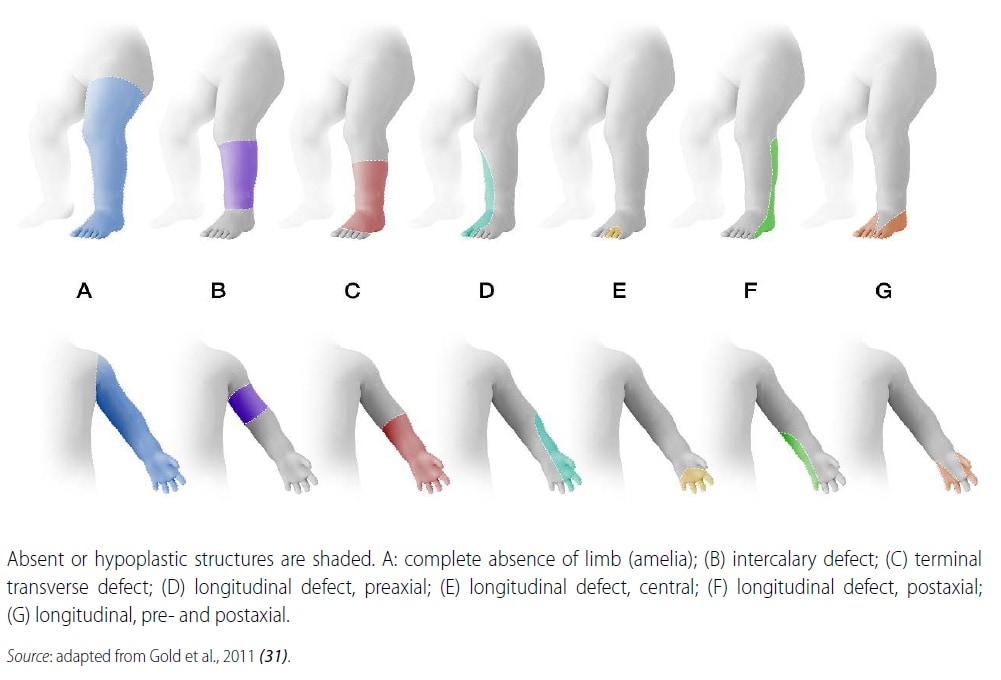Chapter 4.9b Congenital Malformations and Deformations of the Musculoskeletal System: Limb Reduction Defects/Limb Deficiencies
Limb reduction defects, or limb deficiencies, are major structural anomalies characterized by the absence or severe hypoplasia of any limb or part of a limb. Severe hypoplasia can be defined as hypoplasia (small size) with an abnormal shape. This definition helps to distinguish these limb deficiencies from those seen in many skeletal dysplasias (e.g. achondroplasia), where the hypoplasia can be significant but occurs with relatively normal limb shape.
Milder cases of hypoplasia with normal shape are also excluded from this definition of limb deficiency. The main reason is that such presentation does not require treatment and can be considered a minor anomaly. Examples include brachydactyly without severe hypoplasia or absent bones of hand or feet (Q74.80); or clinodactyly, defined as absence/marked hypoplasia of middle phalange of the fifth finger (Q68.10).
Other conditions that are not included in this definition are severe syndactyly (Q70) with partial absence of digits, and sirenomelia (Q87.24), a severe sequence with fusion of lower limbs and visceral anomalies.
The standard nomenclature recognizes two basic types of limb deficiencies – longitudinal and transverse – each comprising additional subtypes. Longitudinal deficiencies occur along the long axis of the limb, and include preaxial deficiencies (radial and tibial side), postaxial deficiencies (ulnar and fibular side), and axial deficiencies (central). In contrast, transverse deficiencies occur across, rather than along, the long axis of the limb, and are distinguished into terminal (more frequent, when the terminal part of the limb is completely missing), and intercalary (when the terminal part of the limb is present, even if abnormal, but the more proximal parts are absent). Classifying limb deficiencies in the specific subtypes is important both clinically and for the purposes of public health surveillance, as the different types tend to differ in their pathogenesis, etiology and associations with other congenital anomalies and syndromes (see Table 4.1 and Fig. 4.35).
Table 4.1. Types of limb deficiencies by axis and segment involved
| Category | Segment | Involvement |
| Complete absence | All segments | Amelia |
| Transverse | Terminal | Absence of terminal part of limb (at any level) |
| Intercalary | Absence or hypoplasia of part of limb with normal or nearly normal terminal part, including: • typical and atypical intercalary defects • femoral hypoplasia |
|
| Longitudinal | Preaxial | Radial, tibial, first (with or without second) digits or toes involved |
| Axial | Hand/foot involved only: Third (with or without second and fourth) ray involved. | |
| Postaxial | Include typical split hand/foot and split hand/foot monodactyly type | |
| Mixed | Any other combination of two or more subtypes. For example, femoral-fibula-ulnar complex. |
Fig. 4.35. Types of limb deficiencies by axis and segment involved

Notes:
- Some of the terms previously used for limb deficiencies should no longer be used because they are either imprecise (ectrodactyly, meromelia, micromelia, hemimelia), or are considered pejorative (“lobster claw”, “seal limb”).
- Overall, the reported prevalence of limb deficiency is approximately 5.0–7.0 per 10 000 births. Transverse terminal defects are the most frequent (around 50%), followed by longitudinal preaxial, longitudinal postaxial, transverse intercalary, and longitudinal axial.
- Limb deficiencies affect upper limbs only in 65% of the cases, followed by lower limbs only, and then both upper and lower limbs. Most cases are unilateral (80%).
- Limb deficiencies are more commonly isolated (50%), but can occur with other birth defects (40%). Syndromes are relatively less common (10%) and are more frequently associated with longitudinal preaxial limb deficiencies.